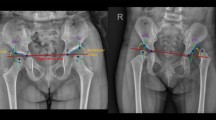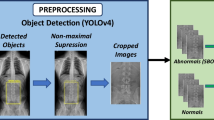Abstract
The rotation and tilt of the pelvis during anteroposterior pelvic radiography can lead to misdiagnosis of developmental dysplasia of the hip (DDH) in children. At present, no method exists for accurately and conveniently measuring the precise rotation and tilt angles of pelvic on radiographs. The objective of this study was to develop several rotation and tilt measurement models using transfer learning and digital reconstructed radiographs (DRRs), and to compare their performances on pelvic radiographs. Based on the inclusion criteria, 30 of 92 children who underwent 3D hip CT scans at Xijing Hospital from 2015 to 2020 were included in the study. Using DRR techniques, radiographs were generated by rotating and tilting the pelvis in CT datasets at − 12 to 12° (projected every 3°) and were randomized to a 2:1:1 ratio of training dataset, validation dataset, and test dataset. Five pre-trained networks, including VGG16, Xception, VGG19, ResNet50 and InceptionV3 were used to develop pelvic rotation measurement models and tilt measurement models, and these models were trained with training dataset. The callback function was used during the training to slow down the learning rate when learning was stalled. Then, the validation set was used to optimize each model and compare their performances. At last, we tested the final performances of optimal rotation measurement model and optimal tilt measurement model on test dataset. The mean absolute error (MAE) was employed to assess the performance of the models. A total of 2430 pelvic DRRs were collected based on 30 CT datasets. Among 5 pre-trained transfer learning models, VGG16-Tilt achieved the best tilt prediction performance at the same BS and different LR. VGG16-Tilt model achieved its best performance on validation set at LR = 0.001 and BS = 4, and the final MAE on the test set was 0.5250°. In terms of rotation prediction, VGG16-Rotation also achieved the best performance, and it achieved its best performance on validation set at LR = 0.002 and BS = 8. The final MAE of VGG16-Rotation on the test set was 1.0731°. Pretrained transfer learning models worked well in predicting tilt and rotation angles of the pelvis on radiographs in children. Among them, VGG16-Tilt and VGG16-Rotation had the best effect in dealing with such problems despite their simple structures. These models deployed in devices can give orthopedic surgeons a powerful aid in DDH diagnosis.




Similar content being viewed by others
Data Availability
The data are available from the corresponding author upon reasonable request and with permission from the Xijing Hospital, Fourth Military Medical University.
Abbreviations
- BS:
-
Batch size
- CNN:
-
Convolutional neural network
- DDH:
-
Developmental dysplasia of the hip
- DRR:
-
Digital reconstructed radiograph
- LR:
-
Learning rate
- MAE:
-
Mean absolute error
- MSE:
-
Mean square error
- ReLU:
-
Rectified linear unit
- VGG:
-
Visual geometry group
References
Weinstein SL, Mubarak SJ, Wenger DR. Developmental hip dysplasia and dislocation: Part I. Instr Course Lect. 2004. 53: 523-30.
Donnelly KJ, Chan KW, Cosgrove AP. Delayed diagnosis of developmental dysplasia of the hip in Northern Ireland: can we do better. Bone Joint J. 2015. 97-B(11): 1572–6.
Kosuge D, Yamada N, Azegami S, Achan P, Ramachandran M. Management of developmental dysplasia of the hip in young adults: current concepts. Bone Joint J. 2013. 95-B(6): 732–7.
Mulpuri K, Song KM. AAOS Clinical Practice Guideline: Detection and Nonoperative Management of Pediatric Developmental Dysplasia of the Hip in Infants up to Six Months of Age. J Am Acad Orthop Surg. 2015. 23(3): 206-7.
Keller MS, Nijs EL. The role of radiographs and US in developmental dysplasia of the hip: how good are they. Pediatr Radiol. 2009. 39 Suppl 2: S211-5.
Simon EA, Saur F, Buerge M, Glaab R, Roos M, Kohler G. Inter-observer agreement of ultrasonographic measurement of alpha and beta angles and the final type classification based on the Graf method. Swiss Med Wkly. 2004. 134(45-46): 671-7.
Roovers EA, Boere-Boonekamp MM, Geertsma TS, Zielhuis GA, Kerkhoff AH. Ultrasonographic screening for developmental dysplasia of the hip in infants. Reproducibility of assessments made by radiographers. J Bone Joint Surg Br. 2003. 85(5): 726–30.
Rosendahl K, Aslaksen A, Lie RT, Markestad T. Reliability of ultrasound in the early diagnosis of developmental dysplasia of the hip. Pediatr Radiol. 1995. 25(3): 219-24.
Wilkin GP, Ibrahim MM, Smit KM, Beaulé PE. A Contemporary Definition of Hip Dysplasia and Structural Instability: Toward a Comprehensive Classification for Acetabular Dysplasia. J Arthroplasty. 2017. 32(9S): S20-S27.
Ghasseminia S, Hareendranathan AR, Jaremko JL. Narrative Review on the Role of Imaging in DDH. Indian J Orthop. 2021. 55(6): 1456-1465.
Starr V, Ha BY. Imaging update on developmental dysplasia of the hip with the role of MRI. AJR Am J Roentgenol. 2014. 203(6): 1324-35.
Fayad LM, Johnson P, Fishman EK. Multidetector CT of musculoskeletal disease in the pediatric patient: principles, techniques, and clinical applications. Radiographics. 2005. 25(3): 603-18.
Chin MS, Betz BW, Halanski MA. Comparison of hip reduction using magnetic resonance imaging or computed tomography in hip dysplasia. J Pediatr Orthop. 2011. 31(5): 525-9.
LeBa TB, Carmichael KD, Patton AG, Morris RP, Swischuk LE. Ultrasound for Infants at Risk for Developmental Dysplasia of the Hip. Orthopedics. 2015. 38(8): e722-6.
Mathews JD, Forsythe AV, Brady Z, et al. Cancer risk in 680,000 people exposed to computed tomography scans in childhood or adolescence: data linkage study of 11 million Australians. BMJ. 2013. 346: f2360.
Sewell MD, Rosendahl K, Eastwood DM. Developmental dysplasia of the hip. BMJ. 2009. 339: b4454.
Yang Y, Porter D, Zhao L, Zhao X, Yang X, Chen S. How to judge pelvic malposition when assessing acetabular index in children? Three simple parameters can determine acceptability. J Orthop Surg Res. 2020. 15(1): 12.
Lee YK, Chung CY, Koo KH, Lee KM, Kwon DG, Park MS. Measuring acetabular dysplasia in plain radiographs. Arch Orthop Trauma Surg. 2011. 131(9): 1219-26.
van der Bom MJ, Groote ME, Vincken KL, Beek FJ, Bartels LW. Pelvic rotation and tilt can cause misinterpretation of the acetabular index measured on radiographs. Clin Orthop Relat Res. 2011. 469(6): 1743-9.
Tönnis D. Normal values of the hip joint for the evaluation of X-rays in children and adults. Clin Orthop Relat Res. 1976. (119): 39-47.
Siebenrock KA, Kalbermatten DF, Ganz R. Effect of pelvic tilt on acetabular retroversion: a study of pelves from cadavers. Clin Orthop Relat Res. 2003. (407): 241-8.
Tannast M, Murphy SB, Langlotz F, Anderson SE, Siebenrock KA. Estimation of pelvic tilt on anteroposterior X-rays--a comparison of six parameters. Skeletal Radiol. 2006. 35(3): 149-55.
Li Q, Zhong L, Huang H, et al. Auxiliary diagnosis of developmental dysplasia of the hip by automated detection of Sharp's angle on standardized anteroposterior pelvic radiographs. Medicine (Baltimore). 2019. 98(52): e18500.
Zhang SC, Sun J, Liu CB, Fang JH, Xie HT, Ning B. Clinical application of artificial intelligence-assisted diagnosis using anteroposterior pelvic radiographs in children with developmental dysplasia of the hip. Bone Joint J. 2020. 102-B(11): 1574–1581.
Lemieux L, Jagoe R, Fish DR, Kitchen ND, Thomas DG. A patient-to-computed-tomography image registration method based on digitally reconstructed radiographs. Med Phys. 1994. 21(11): 1749-60.
Markelj P, Tomaževič D, Likar B, Pernuš F. A review of 3D/2D registration methods for image-guided interventions. Med Image Anal. 2012. 16(3): 642-61.
Commission NH. Requirements for radiological protection in diagnostic radiology: GBZ 130–2020. China. 2020.
Health D. Radiological protection requirements for X-ray computed tomography: GBZ 165–2012. China. 2013.
Omiotek Z, Kotyra A. Flame Image Processing and Classification Using a Pre-Trained VGG16 Model in Combustion Diagnosis. Sensors (Basel). 2021. 21(2).
Han B, Du J, Jia Y, Zhu H. Zero-Watermarking Algorithm for Medical Image Based on VGG19 Deep Convolution Neural Network. J Healthc Eng. 2021. 2021: 5551520.
Rahimzadeh M, Attar A. A modified deep convolutional neural network for detecting COVID-19 and pneumonia from chest X-ray images based on the concatenation of Xception and ResNet50V2. Inform Med Unlocked. 2020. 19: 100360.
Portinaro NM, Murray DW, Bhullar TP, Benson MK. Errors in measurement of acetabular index. J Pediatr Orthop. 1995. 15(6): 780-4.
Acknowledgements
The content of this paper is solely the responsibility of the authors and does not represent the official views of funders. We would like to thank all collaborators and participants, especially Tao Wang and Yajie Yu, for their contribution to our research.
Funding
This study was supported in part by China National Natural Science Foundation [81171735], Shaanxi Natural Science Foundation [2017JC2-04] and Fourth Military Medical University.
Author information
Authors and Affiliations
Contributions
HLY, CH, ZJ and LC contributed to the study design. LC, YYB, and XHF contributed to the data analysis and drafted the manuscript. HLY directed data collection and provided administrative support for the project. All authors contributed to interpretation of the data, commented on the manuscript, revised the manuscript, revised the manuscript, and approved the final version for publication.
Corresponding author
Ethics declarations
Ethics Approval
Approval was obtained from the Ethics Committee of the Xijing Hospital of Fourth Military Medical University. The procedures used in this study adhere to the tenets of the Declaration of Helsinki.
Consent to Participate
Informed consent was obtained from all individual participants and their legal guardians included in the study.
Competing Interests
The authors declare no competing interests.
Additional information
Publisher's Note
Springer Nature remains neutral with regard to jurisdictional claims in published maps and institutional affiliations.
Rights and permissions
About this article
Cite this article
Li, C., Yan, Y., Xu, H. et al. Comparison of Transfer Learning Models in Pelvic Tilt and Rotation Measurement in Pediatric Anteroposterior Pelvic Radiographs. J Digit Imaging 35, 1506–1513 (2022). https://doi.org/10.1007/s10278-022-00672-1
Received:
Revised:
Accepted:
Published:
Issue Date:
DOI: https://doi.org/10.1007/s10278-022-00672-1




